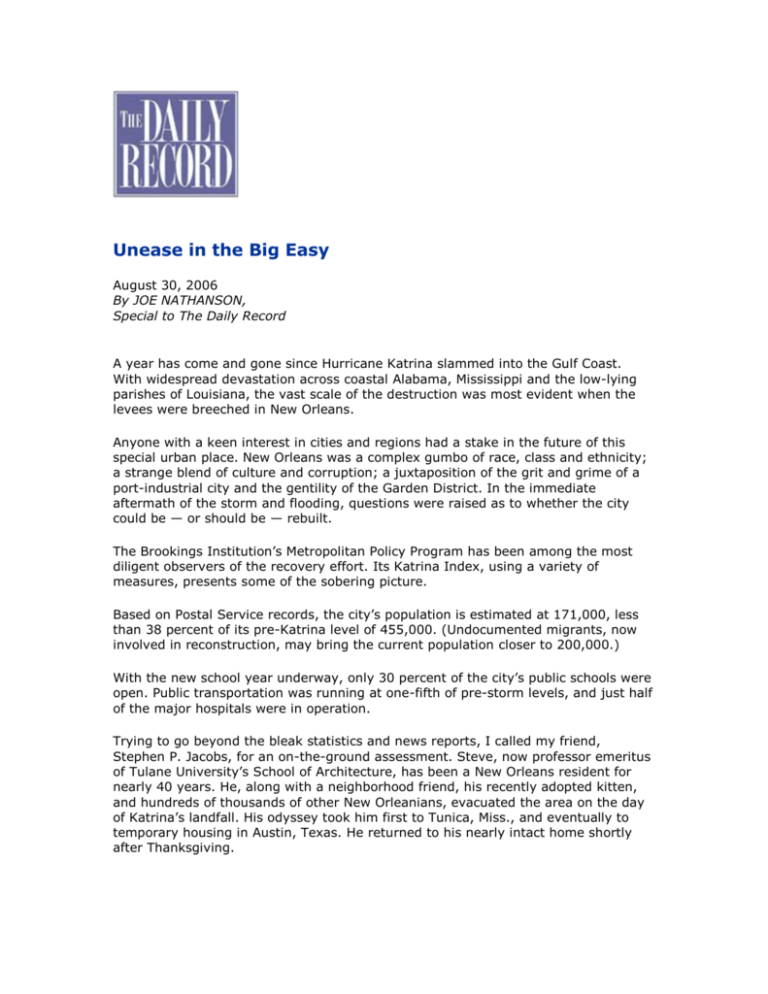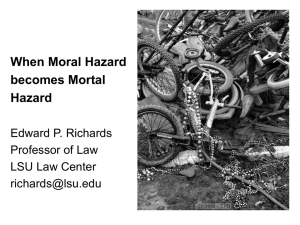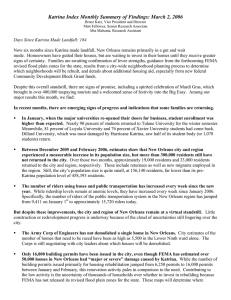
Unease in the Big Easy
August 30, 2006
By JOE NATHANSON,
Special to The Daily Record
A year has come and gone since Hurricane Katrina slammed into the Gulf Coast.
With widespread devastation across coastal Alabama, Mississippi and the low-lying
parishes of Louisiana, the vast scale of the destruction was most evident when the
levees were breeched in New Orleans.
Anyone with a keen interest in cities and regions had a stake in the future of this
special urban place. New Orleans was a complex gumbo of race, class and ethnicity;
a strange blend of culture and corruption; a juxtaposition of the grit and grime of a
port-industrial city and the gentility of the Garden District. In the immediate
aftermath of the storm and flooding, questions were raised as to whether the city
could be — or should be — rebuilt.
The Brookings Institution’s Metropolitan Policy Program has been among the most
diligent observers of the recovery effort. Its Katrina Index, using a variety of
measures, presents some of the sobering picture.
Based on Postal Service records, the city’s population is estimated at 171,000, less
than 38 percent of its pre-Katrina level of 455,000. (Undocumented migrants, now
involved in reconstruction, may bring the current population closer to 200,000.)
With the new school year underway, only 30 percent of the city’s public schools were
open. Public transportation was running at one-fifth of pre-storm levels, and just half
of the major hospitals were in operation.
Trying to go beyond the bleak statistics and news reports, I called my friend,
Stephen P. Jacobs, for an on-the-ground assessment. Steve, now professor emeritus
of Tulane University’s School of Architecture, has been a New Orleans resident for
nearly 40 years. He, along with a neighborhood friend, his recently adopted kitten,
and hundreds of thousands of other New Orleanians, evacuated the area on the day
of Katrina’s landfall. His odyssey took him first to Tunica, Miss., and eventually to
temporary housing in Austin, Texas. He returned to his nearly intact home shortly
after Thanksgiving.
He reports that today, in his new role as a graduate student in Latin American
studies, his own routine is close to normal. His Uptown neighborhood, just west of
the Tulane campus, is on higher ground, suffered limited wind damage and no
serious flooding. He can shop at his nearby Whole Foods market and frequent
familiar restaurants and cafés.
But, Steve goes on to relate, in the neighborhoods east of the French Quarter or
along the shore of Lake Pontchartrain, there is nothing but destruction, “mile after
mile, block after block.” He also notes that some smaller businesses in harder-hit
neighborhoods reopened, only to close again when the area residents did not return.
He recently wrote on his blog: “We are approaching the anniversary of Katrina. …
There was a traditional Jazz Funeral, last weekend, for the pets that were lost to
Katrina. The city seems caught up in a great mood of depression.”
There was a sense of optimism last Sept. 15 when President Bush, standing in the
city’s historic Jackson Square, announced “all who question the future of the
Crescent City need to know there is no way to imagine America without New
Orleans, and this great city will rise again.”
The president went on to present three proposals: a Gulf Opportunity Zone,
providing tax incentives for job creation and loans for small businesses; Worker
Recovery Accounts, providing up to $5,000 to help evacuees by paying for school,
job training or child care while they looked for new employment; and an Urban
Homesteading Act that would make federally owned land in the region available, free
of charge, to low-income people for new home sites.
The president’s commitments were soon followed by congressional appropriations
totaling $110 billion toward Gulf Coast reconstruction. Funds were distributed for
temporary housing assistance and for rebuilding of the New Orleans levee system.
But with the Katrina anniversary now past, the worker recovery accounts and the
urban homesteading proposal are already forgotten. And, the first payments to
individual homeowners for rebuilding are just now beginning to trickle in.
The vacuum of national leadership that marked the immediate response to the
Katrina disaster has its echo in the intermittent attention given by the federal
government to the rebuilding effort over the last year. State and local officials have
also had their problems in coming to a consensus on a plan for reconstruction.
But, there are also energetic state and local leaders on the scene, such as Andy
Kopplin, the executive director of the Louisiana Recovery Authority. And there are
the scrappy, grassroots efforts of the Women of the Storm, who came to Capitol Hill
to dispute the initial allocation of funds to Louisiana. They won their argument.
Barring another catastrophic storm before the levees are fully rebuilt, with
determined grassroots leadership, I’m betting on a smaller, but revitalized New
Orleans of the future.
Joe Nathanson, the head of Urban Information Associates Inc., a Baltimorebased economic and community development consulting firm, writes
Regional Perspectives for The Daily Record. The opinions expressed are his
own and not necessarily those of this newspaper. He can be reached at
urbaninfo@comcast.net.
Copyright 2006 © The Daily Record. All Rights Reserved.












